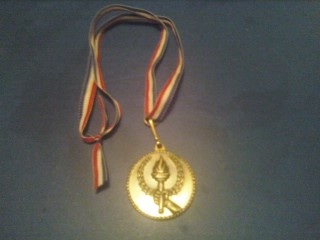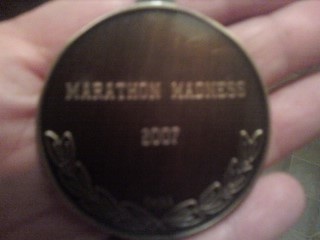|
|
Contextual Learning Portal Marathon Madness
Basics- Project TitleMarathon Madness
- ThemeHistory, Math, Physical Education, Exercise
- Submitted ByMelanie Rancourt
- OrganizationNorth Adams Public School 21st CCLC
- Brief DescriptionMarathon Madness is a self motivating program that helps kids set a goal and monitor their achievement. Within the course of the program students will log 26.2 miles of activity using pedometers and at the end will celebrate by winning gold medals.
- Materials / ResourcesPocket folders for each student, pedometers, pencils, graph paper, calculators, and weekly activity charts.
- Team membersA program leader or teacher and depending on how large your enrollment, the teacher should have an assistant.
- Pre-requisite knowledgeNone
- Technical support neededStudent to teacher ratio should be 12:2 in order to give students individual assistance. An assistant would ensure the safety of the children because this program requires you to take children on long walks around the neighborhood of your school.
- Any modifications or extensions for particular student populations?No modifications are needed however assistance with calculations and graphing maybe needed at first until students get used to logging their information.
Key Questions- Key Questions1. What is the story/history behind the marathon?
2. Where did the marathon originate?
3. How long is a marathon?
4. How do you calculate steps into miles? - Connections: How or why was this topic identified? Why is it meaningful?A few years ago our school district looked very seriously at the growing obesity problem among young children. Over the summer I had an idea and with a little research, created this program. Students enjoyed the challenge and I ran it for a few years.
- Background Research: What resources were used to find background information for this project?The book The First Marathon: The Legend of Pheidippides by Susan Reynolds was read to the children and the company Walk4life was discovered on the internet (see e-mail document). They supplied us with our pedometers (generous donation!)
-
View/Download File: /project113_3526/Email.doc - Outcomes: What was the outcome? How was it shared or applied in the community?All students were active enough during our 16 week after school program that they logged enough steps to total 26.2 miles. News of this program was shared with the community and it was stressed that the school district was actively engaged in keeping our children fit and in healthy shape. A healthy party was held on the last day and students received their gold medals.
Units / Activities - First day intorductions and explanation of program and set up.
2 hoursFor 15 minutes.....hand out a folder to each student. Have them right their names on it. Show students the weekly logs and explain how to do the math conversions (example on the log sheet) Explain how long a marathon is and tell students that this is their goal. The more they walk, play and exercise, the more steps they will get.
Then hand out pedometers and have students put the clips on their waste or shoe. Go outside and take a walk and play in the play ground. This should last for 1 hour 30 min.
The last 15 minutes of the day, come back in and have students look at their pedometers. Write down their steps, use the calculator to divide and write down the miles walked. Write that in the next column. pocket folders for each student, graph paper, weekly log sheets, pedometers, pencils and calculators -
View/Download File: /project113_3526/Weekly Log Sheet of Exercise.doc - Week 2
Who is Phidippides, exercise
2 hoursFor 15 minutes....introduce the students to Phidippides. Read to them The Role of Phidippides (see attachment) Show the students pictures too. (see attachment)
Then hand out pedometers and have students put the clips on their waste or shoe. Go outside and take a walk and play in the play ground. This should last for 1 hour 30 min.
The last 15 minutes of the day, come back in and have students look at their pedometers. Write down their steps, use the calculator to divide and write down the miles walked. Write that in the next column. **Make sure students now add together the miles from last week to come up with a new total. Folders with log sheets, pedometers,pencils and calculators.
-
View/Download File: /project113_3526/Pictures.doc View/Download File: /project113_3526/The Marathon Story.doc - Week 3
The First Marathon:The Legend of Pheidippides, exercise
2 hours
For 15 minutes.....read the first 10 pages of the book
The First Marathon: The Legend of Pheidippides by Susan Reynolds.
Follow the same 1 hour and 30 minute activity as in previous weeks.
The last 15 minutes is the same also. log, divide and add miles.
The book The First Marathon: The Legend of Pheidippides by Susan Reynolds, Folders with log sheets, pedometers, pencils and calculators. -
View/Download File: /project113_3526/Literature Connection.doc - Week 4
Read and exercise!
2 hoursRead the next 11 pages of the book
The First Marathon: The Legend of Pheidippides by Susan Reynolds, exercise, log, divide and add miles.The book The First Marathon: The Legend of Pheidippides by Susan Reynolds, Folders with log sheets, pedometers, pencils and calculators. - Week 5
Read and exercise!
2 hours
Read the last 11 pages of the book
The First Marathon: The Legend of Pheidippides by Susan Reynolds, exercise, log, divide and add miles.The book The First Marathon: The Legend of Pheidippides by Susan Reynolds, Folders with log sheets, pedometers, pencils and calculators. - Week 6
Graph and exercise!
2 hoursFor a different type of math connection, begin to graph progress now that there is 5 totals to graph. Y-axis can be the miles and x-axis can be the weeks 1-16. Help students set up their graph using a teacher generated example. Then exercise, log, divide and add miles.Graph paper, pencils, Folders with log sheets, pedometers, and calculators.
- Week 7
Exercise
2 hours
For the next several weeks the majority of the steps will be logged. Start exercising (walking and playing on the playground) as soon as the program starts. Make sure each student gets a pedometer. 15 minutes before the end of the program, log, divide, add miles, and graph progress.Folders with log sheets and graphs, pedometers, pencils and calculators.
- Week 8
Exercise and record data
2 hoursSame as week 7Folders with log sheets and graphs, pedometers, pencils and calculators.
- Week 9
Exercise and record data
2 hoursSame as week 7Folders with log sheets and graphs, pedometers, pencils and calculators.
- Week 10
Exercise and record data
2 hoursSame as week 7Folders with log sheets and graphs, pedometers, pencils and calculators.
- Week 11
Exercise and record data
2 hoursSame as week 7Folders with log sheets and graphs, pedometers, pencils and calculators.
- Week 12
Exercise and record data
2 hoursSame as week 7Folders with log sheets and graphs, pedometers, pencils and calculators.
- Week 13
Exercise and record data
2 hoursSame as week 7Folders with log sheets and graphs, pedometers, pencils and calculators.
- Week 14
Exercise and record data
2 hoursSame as week 7Folders with log sheets and graphs, pedometers, pencils and calculators.
- Week 15
Exercise and record data
2 hoursSame as week 7Folders with log sheets and graphs, pedometers, pencils and calculators.
- Week 16
Awards ceremony and party!!Most students should have completed the required 26.2 miles already or are very close. Regardless..reward everyone for their hard work by having a medal ceremony after the exercise for the week is complete. Invite the principal of the school and parents to come early. Show parents how students log in steps and add miles. Allow students to take their folders home and celebrate with a healthy snack!! Folders with log sheets and graphs, pedometers, pencils and calculators, gold metals (see attachments of pictures of a medal I saved), juice, fruits, veggies with dip.
-
 
Instructional Techniques - Literature/Reading ComprehensionDue to time restrictions in a 16 week program, the teacher should read the stories to the students. If there is time, students should read.
Discuss with students the historical importance of such an event.
Ask questions to students to ensure comprehension. - GraphingAssist students create a graph that they can use to plot their progress. I prefer a line graph.
- Calculations using whole numbers and decimalsShow students that the # of steps divided by the # of steps in a mile (2640) equals miles of walking a student did that day. Keep adding the weekly totals together until the program is over. The goal is over 26.2 miles
- Motivation and good healthSetting a goal of 26.2 miles in a 16 week period will motivate students to achieve that goal and run a marathon. Allow students to help plan the ending celebration by choosing the fruits and veggies that they want to eat.
- Data CollectionLog totals from pedometers each week and keep a running record of progress.
Assessment Techniques- Literature/Reading ComprehensionWhile on the weekly walk, discuss the readings and ask questions. Correct answers will show comprehension.
- GraphingAssist students at first with plotting data on their graphs, however, as the weeks go on, students should be able to complete this task independently. Bring folders home and check for accuracy. If there is a problem, show student his/her mistake the next week.
- Calculations using whole numbers and decimalsAssist students at first with the steps formula. (dividing) and then adding the data on their weekly log in sheet. however, as the weeks go on, students should be able to complete this task independently. Bring folders home and check for accuracy. If there is a problem, show student his/her mistake the next week.
- Motivation and good healthWhen students go on walks or play on the playground make sure they are busy moving around. The more movement, the more steps, the more progress!
- Data Collection/OrganizationShow students how to organize their data on their weekly log in sheet and graph. As the weeks go on, students should be able to complete these tasks independently. Bring folders home and check for accuracy. If there is a problem, show student his/her mistake the next week.
Tags = fitness | math | Subject = ELA, Mathematics, Physical_Education | Grade Level = Elem | Time Period = 21st CCLC | Program/Funding = 647 |
Direct website link to this project: http://ContextualLearningPortal.org/contextual.asp?projectnumber=113.3526
|


